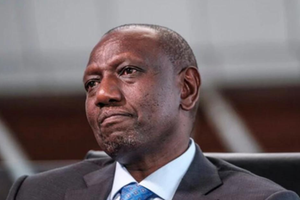
The killing of magistrate Monica Kivuti during court proceedings at the Makadara law courts is unprecedented in Kenya’s recent judicial history but not unexpected.
Due to endemic laxity in security screening, fatal danger always lurks in most court precincts in the country, aided by the impunity that allows licensed gun holders and armed police officers to roam within the premises.
That a gun attack inside a courtroom was not far-fetched had been evident as late as four months earlier.
On February 12, this year, Musa Salim, a theft suspect on trial, snatched a gun from a prison warder during a court session in Mombasa but was disarmed when the weapon failed to discharge. A mass shooting was averted.
Preliminary reports show the attack on Ms Kivuti was enabled by a foreseeable security lapse and an assassin determined to avenge the detention of his associate.
A trained police officer, Samson Kipchirchir Kipruto easily breached familiar security loopholes, having worked in the vicinity in the past.
A statement by Chief Justice Martha Koome stated: “The intention of the perpetrator was to kill the magistrate.”
Special entrance
Justice Koome described the killer as a “senior court user who had open and unfettered access to the courtroom through the magistrate’s special entrance.”
But it beggars belief why a stranger was allowed “unfettered access” to a magistrate’s chambers or entrance, except for laxity, impunity and that he was a senior policeman.
There have been past attacks on judicial officers, but the brazen onslaught inside a courtroom targeting the magistrate presiding over an open session has escalated the crime to dangerous levels.
Twenty-five years ago, an off-duty magistrate was assassinated at the Riara-Makini roads junction in Nairobi in an attack linked to his job.
The court would hear during the trial of suspects that the plot to kill magistrate Babu Achieng, who was shot on January 15, 1999, had been hatched in a Nakuru hotel.
The unsolved daylight assassination of Nakuru Chief Magistrate Babu Achieng on January 15 1999 shook the nation and legal fraternity.
Mr Achieng was shot by two gunmen as his five-year-old daughter watched.
Carjacking was initially suspected as motive but allegations emerged later that disgruntled litigants ordered the assassination as retribution after the magistrate refused to accept a Sh280,000 bribe. After a prolonged trial, three men were acquitted of the murder charges amid concerns about shoddy investigation and prosecution.
Several judges and judicial officials as well as their relatives and aides have also been kidnapped, robbed and threatened with death, sometimes forcing them to abandon trials.
In March 2003, then Registrar of the High Court William Ouko was abducted from his Lavington home and dumped in Eastlands in Nairobi. At the time, Mr Ouko was also serving the Goldenberg Commission of Inquiry. He is now a Supreme Court judge.
The motive for the October 24, 2017, shooting of Justice Philomena Mwilu’s bodyguard and driver, Titus Musyoka, as the Supreme Court judges were preparing to hear a petition on a repeat presidential election, has only been speculated.
Weeks earlier, Justice Mwilu and three Supreme Court judges had nullified that year’s presidential elections. When a second petition threatened to halt the repeat poll, armed men sprayed Mr Musyoka’s car with bullets, minutes after he had dropped off the judge at a shop in Nairobi.
The Supreme Court could not sit the next day to decide this petition for lack of quorum.
Eleven years ago, Justice Mary Nzioka and her husband were held hostage at her Nairobi home by armed assailants who ransacked the house for documents and stole money.
Justice Nzioka was preparing a judicial report on the 2013 ethnic bloodletting in Tana River County, which implicated top police, political, intelligence and military officials in the mass murders. The attack on the judge was, apparently, intended to force her to abandon the inquest.
The Executive has never published the report despite receiving it from the judge.
In September 2018, nine-year-old Maribel Kapolon, daughter of Ms Caroline Kemei, a magistrate stationed in Central Imenti, was abducted and murdered after a ransom demand in an apparent revenge killing.
A few other examples illustrate the state of general security laxity in most courts in the country.
Twice within the same court in Mombasa in 2007, a female magistrate, Teresia Mwangi, was sprayed with human faeces smuggled into court by male suspects.
Twenty years ago, a relative reportedly smuggled a pistol hidden in a loaf of bread to a suspect in the Mombasa law court cells, which was used to free the suspect and other inmates.
And the State stringently denied press reports that a live grenade was found in a Mombasa court after a court session.
General lawlessness
Magistrates, judicial officers and judges, as part of the larger society, are often victims of general lawlessness that enables terrorism to take root.
A tiny minority also courts danger by dealing with criminals. Most are susceptible to attacks by State and non-State actors on account of their jobs.
There is no reliable study in Kenya to enable an objective determination of the nature and scope of the problem.
But comparative studies by Amnesty International in Philippines in 2021 established that State inspired incitement and neglect, including by the president, can be a leading enabler of violence against judges and lawyers.
The assassination of magistrates, judges and court officials, while rare in Kenya, is common in other countries, including the USA, India and Philippines.
A report by CNN shows that between 1979 and this year, three federal judges—Richard Daronco, John Wood and Robert Vance, and several other lower court judges, have been targets of attacks.
This century, about 20 judges at various levels have been assassinated in the USA. The motive for killing magistrates, judges and other court officers range from disgruntlement with rulings and judgments, the intention by State and non-State actors being to instill fear and sway courts to rule in particular ways.
In 2023, according to a CNN report, 1,061 threats, including hate messages and threatening calls, were made to the judiciary. The highest such threats were 4,542 reported in the USA in 2018. In the US, judges have been killed by parcel bombs delivered by post and in drive-by shootings ordered by drug lords, disgruntled litigants, fugitives and ideologically motivated activists.
Judge Andrew Wilkinson
The October 21, 2023 murder of Judge Andrew Wilkinson by an aggrieved litigant comes closest to the Kenyan case. A day before he was fatally shot in his parking lot, Wilkinson had ruled against Pedro Argote, an estranged husband in a divorce and child custody battle against his wife.
The judge ordered a divorce and granted full custody of the children to Pedro’s wife. Pedro was also ordered to pay a fine of $1,120.
Pedro died days later from alleged suicide. Like Pedro, Kipruto had found the magistrate’s decision to cancel his wife’s bond and detain her for absconding court unbearable.
Another US case with parallels to magistrate Kivuti’s murder is the March 11, 2005 fatal gun attack by Brian Nichols, a convict who fled from police while being led to a courtroom on a second rape charge.
Killed the judge
Nichols grabbed a gun, burst into Judge Rowland Barnes’ chambers and killed the judge and a journalist.
On May 21 1988, Judge Richard Daronco was shot and killed in his New York home by a man dissatisfied by the judge’s dismissal of a sex discrimination suit against the assailant’s daughter.
Besides political motives to intimidate, judges have been attacked or killed by obsessed attackers with no clear motive as happened in the April 9 2021 murder of Judge Sandra Feuerstein by a deranged drug induced stalker.
Disgruntled drug lords and criminals often order hits on the judges who take bribes and rule contrary to instructions. A few years ago, there were reports that a judge in Kenya was embroiled in an altercation with his police bodyguard after the latter vanished with a huge bribe he had collected for the judge.
Apparently, the judge habitually sent the disgruntled policeman to collect bribes in suitcases without any payment. It is claimed that one day, the officer decided to help himself to the loot and he vanished. The judge tried to report to police but backed down when the policeman threatened to expose him. The officer was quietly redeployed.
The writer is a journalist and Advocate of the High Court based in Mombasa.





